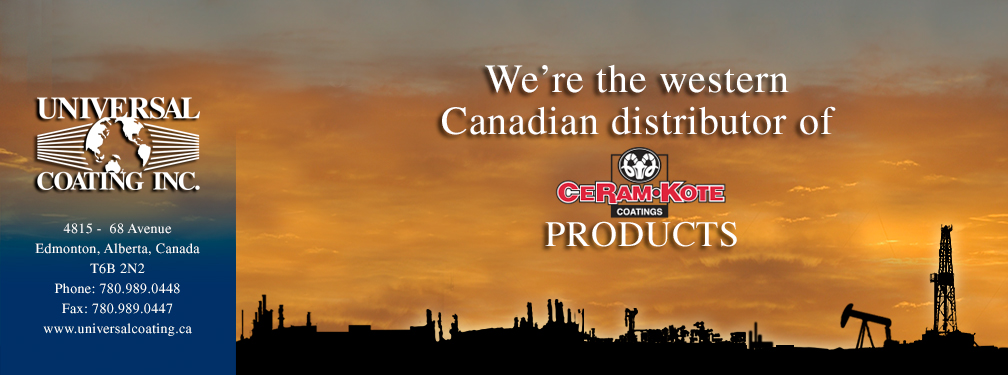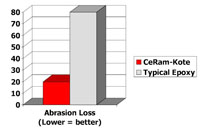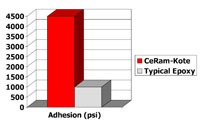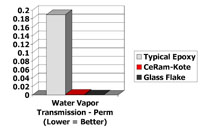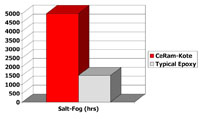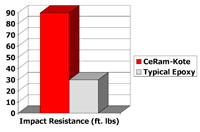Use the buttons below or the Menu on your right to navigate through the specifications...
1.0 Scope
This is the general specification covering materials and procedures for the thin-film, CeRam-Kote Ceramic Epoxy coatings. More detailed, job-specific specifications may be obtained from Freecom, Inc.
2.0 General
The effectiveness of a coating as a corrosion preventative is dependent on whether or not it forms a tightly adherent, impervious, chemically resistant barrier over the surface of the substrate to be protected. All three of these factors are directly affected by the quality of work performed by the coating applicator. As a consequence, the coating applicator shall strictly follow all the requirements set forth in this specification, the coating manufacturer's recommendations and good industrial practice. Workmanship shall be first class in every respect.
3.0 Surface Preparation
All surfaces must be free of dirt, grease and oils prior to sand blasting or abrading. Alkali degreasers such as Devprep88, Klenzade Alkali degreaser or BP Comprox HD alkali degreasers should be used before abrasive blasting. They should not be permitted to dry on the substrate and should be rinsed from the substrate thoroughly with clean fresh water.
3.1 Steel, Stainless Steel, Titanium, Aluminum
Grit blast, with sand, steel, garnet, plastic or other media, etc., all metal material ideally to a NACE-1 (SSPC-SP5, Swedish-Sa 3) White Metal but no less than NACE-2 (SSPC-SP10, Swedish-Sa 2 1Ú2) Near White Metal finish. At all times, an anchor profile should be 2 to 2 1Ú2 mils (50 - 62.5 microns).
For stainless steel and aluminum, if necessary, blasting for profile may be done in the days prior to the application, but the surface must be additionally sweep or brush off blasted the day of the application to ensure all oxides have been removed and chlorides are at a minimum.
3.2 Fiberglass and composite materials
When preparing old or previously used fiberglass or plastic material, rough-up or abrade with sandpaper. For new fiberglass, clean and wipe all surfaces with Acetone, Isopropyl Alcohol (99% pure) or Methyl Ethyl Ketone (MEK) prior to profiling to remove mold release agents, wax and contamination prior to abrading. Fiberglass and composite materials must have a water content of less than 5%.
3.3 Galvanized
If the surface is newly galvanized (that is, less than 48 hours out of the zinc kettle), the surface can be coated after a slight roughening of the surface (i.e. 100 grit sandpaper or abrasive sweep blast*). If the surface of the galvanized part has been exposed to the environment for more than 1 year, the surface can be coated after the dirt, grease, oils, and salt contamination have been removed (i.e., either solvent wipe, alkaline wipe, etc.). The most difficult time to paint galvanized steel is between 1 day and 1 year after it has been galvanized. Freecom recommends sweep blasting* of the galvanized surface to remove the natural corrosion by-products of the galvanized surface {i.e. Zinc Oxide and Zinc Hydroxide)}.
*Care should be taken to prevent removing too much of the galvanized coating. Particle size for a sweep blast of galvanized steel should be between 200 and 500 mm.
3.4 Welds, joints, and edges.
All welds are to be ground reasonably smooth, removing all weld splatter and slag. Sharp edges in areas to be coated shall be ground to a minimum radius of 1/16Ó of an inch (1.5 mm).
3.5 Ultra-High Pressure Water Jetting.
All surfaces to be recoated shall be cleaned in accordance with NACE/SSPC WJ-1/SC-1 with UHP WJ of at least 30,000 psi (2,000 bar). Do not use corrosion inhibitors. Chloride removers should be used as a substitute. If in an enclosed area, dehumidification equipment should be used to ensure quick drying of the substrate. CeRam-Kote thin-film coatings should be applied as soon as possible to limit the amount of flash rusting that occurs. C Vis WJ-2 L and C Vis WJ-2 M are acceptable. C Vis WJ-2-H is not acceptable per SSPC-VIS 4(I) / NACE 7 visual standards. Once the rust is adhered and classified as corrosion of the substrate, then the rust is no longer acceptable.
**Prior to coating, all surfaces should be tested for chlorides. Ten (10) ppm of chlorides is the maximum level for internal or immersion service (internal vessels) and twenty (20) ppm is the maximum for external or atmospheric service (pipelines, external vessels). The acceptable level for hulls below the water line is <3 ppm. Any readings outside of the above-specified parameters will be treated with a soluble salt remover.
All surfaces must be free of contaminates. Freecom recommends checking all substrates for salt contamination prior to blasting and prior to coating.
4.0 Mixing
CeRam-Kote thin-film Ceramic Epoxy Coatings are packaged in two cans, Part A (coating) and Part B (curing agent). The mix ratio varies for each CeRam-Kote formula. Please refer to individual Product Data Sheet for volume and weight mixing ratios. Shake Part A (coating) with a Cyclone air powered shaker or mix Part A with an Edsan's Jiffler Mixer until all the ceramic powders are suspended in the resin. The time required to place the ceramics into suspension depends on how long the material has been on the shelf and the temperature of the storage facility. Regardless of time needed, shake or mix all ceramic material into suspension first.
4.1 When using a Cyclone Air Shaker
If Part A (coating) sits for 30 days or less at room temperature 72¡F (22.2¡C) and the air powered shaker is in good working order, a four (4) to six (6) minute shake will place the ceramic powders into suspension. If Part A (coating) sits in excess of 30 days or at a colder temperature than room temperature 72¡F (22.2¡C), a longer shake will be required to place the ceramic powders into suspension. If all the ceramic powders of Part A (coating) are not in suspension, the ceramic and resin ratio becomes unbalanced and the material will not cure or perform properly. Check the coating to assure that all solids are in suspension prior to proceeding to the mixing step. Stirring, other than the use of the air powered Jiffler system described below, will not get the ceramic powders into suspension.
Combine Part A (coating) and Part B (curing agent) and shake until both parts are thoroughly mixed. The amount of time required depends on the temperature of parts A and B and the working condition of the shaker. If Part A (coating) and Part B (curing agent) are at room temperature 72¡F (22.2¡C) and the shaker is in good working condition, a three (3) to four (4) minute shake is all that is required. However, caution must be used to prevent heat build up. Never allow the catalyzed coating to get above 100¡F. The pot life for CeRam-Kote Ceramic Epoxy Coatings at 72¡F (22.2¡C) is approximately four (4) to six (6) hours. Colder temperatures will increase the pot life and warmer temperatures will decrease the pot life.
4.2 When using a Edsan's Jiffler Mixer
CeRam-Kote Ceramic Epoxy Coatings can also be mixed by using the Edsan's Jiffler Mixer, Model EPM-000. This Jiffler Mixer can be used for one (1) gallon kits at on-site jobs where the use of the Cyclone Air Shaker is not practical or where five (5) gallon kits are to be used. This mixer is an air motor driven mixing blade system that places CeRam-Kote Ceramic Epoxy Coatings Part A into suspension prior to adding Part B and is also used to make the catalyzed mix. The maximum recommended operating pressure of the Jiffler mixer is 100 psi (7 bar).
When Part A (coating) is stored for 30 days or less at room temperature 72¼F (22.2¼C)) and the air motor is in good working condition, a fifteen (15) to twenty (20) minute mix will place the ceramic powders into suspension in a five (5) gallon pail. A ten (10) to fifteen (15) minute mix will normally place the ceramic powders in a one (1) gallon can in suspension. When mixing, stop after five (5) or six (6) minutes and scrape the sides of the container. Regardless of time needed, mix all ceramic material into suspension prior to proceeding.
When Part A (coating) is in suspension, add Part B (curing agent). The amount of time required to make a mix depends on the temperature of parts A and B and the working condition of the mixer. For a five (5) gallon pail, Part A (coating) and Part B (curing agent) should be mixed for three (3) or four (4) minutes at room temperature 72¡F (22.2¡C). For a one (1) gallon can, two (2) or three (3) minutes should be sufficient. Caution must be used to prevent heat build up. The pot life of CeRam-Kote Ceramic Epoxy Coatings at 72¡F (22.2¡C) is approximately four (4) to six (6) hours. Colder temperatures will increase the pot life and warmer temperatures will decrease the pot life.
4.3 Thinning
CeRam-Kote thin-film coatings are shipped from the factory with a viscosity of 60-90 seconds so thinning will be required prior to application. Adjust viscosity with small amounts of Acetone, Methyl Ethyl Ketone (MEK) or Isopropyl Alcohol (99% pure). Use caution when thinning, as a little thinner goes a long way. Do not over thin.
4.4 Misc.
After shaking or mixing CeRam-Kote Ceramic Epoxy coatings, strain with a standard paint strainer and pour the mix into the spray equipment. The pot life of the catalyzed material at 72¡F (22.2¡C) lasts four (4) to six (6) hours. If the material is exposed to heat by excessive shaking or a paint pot and paint lines are exposed to direct sunlight, pot life is drastically reduced.
5.0 Coating Application
For best results, spray-apply CeRam-Kote thin-film, Ceramic Epoxy coatings. Use pressure feed equipment such as high-volume, low-pressure (HVLP) equipment or Binks 2001 conventional spray equipment. Use Tungsten Carbide needles and fluid nozzles for maximum life and to prevent damage to the spray equipment. The compressed air source should be outfitted with air dryers as needed to supply moisture-free air. The air source must be dry. Moisture inhibits the catalytic reaction and produces an unsatisfactory finish that performs poorly.
| Type | HVLP | Conventional |
| Needle | 54-3950 Carbide | 563 CVT Carbide |
| Fluid Nozzle | 94VT (0.052") 1.33mm Carbide Tip | 63CVT Carbide |
| Air Nozzle | 97P | 63PB |
Airless equipment may also be used to apply CeRam-Kote Ceramic Epoxy Coatings to large areas. The carbide tip should be reversible and have an orifice size of 0.019-0.021inches.
CeRam-Kote Ceramic Epoxy Coatings may also be brush or roll applied. To brush, use a very fine bristled brush with natural bristles. To roll, use a high quality roller with a 1Ú4 inch (6.35 mm) or shorter nap.
Stripe Coating: All welds, joints, edges, and angle bars must be stripe coated with a light pass of two (2) to three (3) mils either by brush or spray application. Structures that cannot be reached by spraying must be stripe coated as well. It is recommended that contrasting colors of CeRam-Kote be utilized during this process to ensure proper coverage. Apply a first pass of four and one-half (41Ú2) to six (6) mils to the entire substrate (including the areas previously striped) and allow it to sit until tacky. Normally, thirty (30) to forty (40) minutes is sufficient, but allow more time if the temperature is below 70¡¡F (21.1¡¡C) or if more time is simply needed. Refer to FreecomÕs CSDS 1 for detailed instructions on cure time. Apply a second pass of four and one-half (41Ú2) to six (6) mils to the entire substrate for a total dry film thickness (DFT) of seven (7) to ten (10) mils. Apply additional mils, if recommended by factory, without incurring runs or sags.
Whenever possible, always apply the second coat in a cross-coat method to the first coat.
The finished application of the material appears glossy when wet. At room temperature 72¡F (22.2¡C) CeRam-Kote Ceramic Epoxy Coatings gel in approximately three (3) hours, a seventy percent (70%) cure is achieved within twelve (12) hours. A full cure is achieved in 2 to 7 days, depending on curing temperature.
Should a more rapid cure be desired, CeRam-Kote thin-film, Ceramic Epoxy Coatings can cure in one (1) hour if the temperature is elevated to 150¡F (65.6¡C), however, some flexibility is lost by rapid-curing
Unless in a controlled environment, coating will only be permitted during daylight hours when air and substrate temperature is above 40¡F (4.4¡C). No coating will be permitted when substrate is wet from rain or dew, when surfaces are less than 5¡F (3¡C) above the dew point, or when the relative humidity is greater than 85%. Moisture will inhibit the curing agent reaction in the coating system and the coating will not cure or perform properly.
To achieve highest gloss possible, and to deter amine blush issues with CeRam-Kote 54¨ and CeRam-Kote 99: Once substrate has been coated, wait at least 5 minutes, but not longer than 30 minutes. Apply 120¡F to 130¡F (49¡C to 54¡C) heat to coated item. Allow substrate of item to reach 120¡F to 130¡F (49¡C to 54¡C). Once this occurs, remove heat.
6.0 Top Coating CeRam-Kote Ceramic Epoxy Coatings with an Epoxy Compatible Topcoat
6.1 For optimum adhesion, CeRam-Kote Ceramic Epoxy Coatings must be topcoated when the CeRam-Kote Ceramic Epoxy Coating is still soft but dry to the touch (using thumbnail impression test, the coating will be marked but will not adhere to thumbnail). This is the preferred topcoating application method.
6.2 Alternatively, if the CeRam-Kote Ceramic Epoxy Coating is cured beyond the dry to the touch stage:
6.2.1 Solvent wipe surface to remove contaminates.
6.2.2 Lightly sand with 80-100 grit paper.
6.2.3 Solvent wipe to remove any residue.
6.2.4 Apply a mist coat of the CeRam-Kote Ceramic Epoxy Coating.
6.2.5 Apply the epoxy compatible topcoat per instruction in 6.1 above.
6.3 For option 6.1, if the coating is beyond the dry to the touch stage, the surface must be checked for chloride contamination. Ten (10) ppm of chlorides is the maximum level for internal or immersion service (internal vessels) and twenty (20) ppm is the maximum for external or atmospheric service (pipelines, external vessels). The acceptable level for hulls below the water line is <3 ppm. Any readings outside of the above specified parameters will be treated with a soluble salt remover such as Chlor*rid.
7.0 Safety
Wear a Charcoal-filtered mask, safety glasses, and gloves when applying CeRam-Kote Ceramic Epoxy coatings. Read the Material Safety Data Sheet (MSDS) completely to ensure that all safety procedures are followed.
8.0 Clean Up
Purge and clean spray equipment within thirty (30) minutes of the final spray. Flush equipment with Acetone, Methyl Ethyl Ketone (MEK), or Isopropyl Alcohol (99% pure) until solvent sprays clear. Disassemble and clean equipment to manufacturer's recommendations. Material left in spray equipment could solidify and damage equipment. Use precautionary measures applicable to any catalyzed material.
9.0 Repairs
If the CeRam-Kote coating is less than forty-eight (48) hours old and has not been exposed to contamination, repair by wiping with Acetone, Methyl Ethyl Ketone (MEK), or Isopropyl Alcohol (99% pure), then reapply CeRam-Kote Ceramic Epoxy coating.
If coated parts have been exposed to contamination and/or coated for longer than forty-eight (48) hours, repair by sanding with 40 to 60 grit sand paper then wipe with Acetone, Methyl Ethyl Ketone (MEK) or Isopropyl Alcohol (99% pure). Make certain the substrate is totally free of all contamination and is white-metal clean NACE-1, no less than NACE-2. Once the substrate is totally clean of contamination, reapply CeRam-Kote Ceramic Epoxy coating to specification. If an amine blush or water spotting has occurred, be aware this is only cosmetic. It has only occurred at the air-to-coating interface. The surface must be sanded aggressively to remove the contamination back to unaffected coating before another coat of CeRam-Kote Ceramic Epoxy coating can be applied.
If the coated parts have been exposed to actual operating conditions for longer than seventy-two (72) hours, the effected substrate must be cleaned to NACE-1 white metal, no less than NACE-2 Near white metal. Ideally, sandblasting the effected substrate is best to achieve the needed anchor profile and to remove all contamination. Second option is to sand with 40-grit sandpaper to achieve contamination free substrate. It is recommended the substrate be checked for soluble salts before and after substrate preparation (see section 6.3 above for limits).
10.0 Holiday Detection
Use a 671Ú2-volt, wet sponge spark detector set at 80,000 ohms resistance, such as Tinker and Rasor model M-1. If a holiday is detected, mark the area with an oil free chalk and repair according to 9.0.
11.0 Coverage
The formula for theoretical coverage of CeRam-Kote thin-film, Ceramic Epoxy Coatings without considering loss factors is:
1604 X Solids Content by Volume
Dry Film Thickness Required in Mils = ft2/gal Theoretical Coverage
12.0 Pot Life and Shelf Life
Pot life is approximately four (4) to six (6) hours at 72¡F (22.2¡C) with medium humidity. Colder temperatures will increase the pot life and warmer temperatures will decrease the pot life. Excessive heat decreases pot life rapidly. At 100¡F (37.8¡C), the pot life is one (1) hour.
If stored in a dry enclosed area under 70¡F (21¡C), CeRam-Kote Ceramic Epoxy Coatings have an indefinite shelf life. However, it is recommended that CeRam-Kote Ceramic Epoxy Coatings be used within two years of delivery.
13.0 Cure Schedule
A two-pass film of seven (7) to ten (10) mils (175-250 microns) dries to a touch-dry (gel) finish within three (3) hours at 72¡¡F (22.2¡¡C) and dries to a 70% cure in twelve (12) hours. Cure times lengthen at lower temperatures and shorten at higher temperatures.
14.0 Miscellaneous
If the mixed coating sits for more than two hours, the ceramic solids in CeRam-Kote Ceramic Epoxy Coatings may settle out slightly. Shake or stir again. Shake one (1) quart or two (2) quart systems by hand to ensure suspension of solids if spraying is interrupted for more than an hour.
If coating is to be used in potable water, it is recommended to high-pressure water wash the finished, cured coating with an alkaline degreasing solution such as Devprep 88. After alkaline solution has been applied per manufacturers instructions, rinse surface with fresh water.
15.0 Warranty
The information, data and suggestions contained herein are believed to be reliable, based upon our knowledge and experience; however it is expressly declared that Seller does not guarantee the result to be obtained in Buyer's process. SELLER HEREBY EXPRESSLY DISCLAIMS ANY IMPLIED WARRANTY OF MERCHANTABILITY FOR FITNESS FOR A PARTICULAR PURPOSE AND/OR ANY OTHER WARRANTY, EXPRESS OR IMPLIED as to any and all products and or suggestions described herein, whether such products are used alone or in combination with other materials. Buyer must make its own determination of the suitability of any product of its use, and the completeness of any information contained herein. Licensed applicators are independent contractors and are not agents or employees of Freecom.
*CeRam-Kote 2000 and CeRam-Kote 60 are not considered to be food grade.

